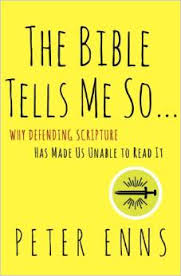ch. 5 a long form book response to The Bible Tells Me So by Peter Enns
Until last autumn, I had not read any of Dr. Peter Enns' books although I am a regular reader of his blog at Patheos, "rethinking biblical christianity..." I did write a brief review in November and after writing the long form book response to Flood's book Disarming Scripture, I thought it would benefit me to reflect more on this book as well. It is an excellent book and written in a more accessible style than Flood's. There are only seven chapters with numerous sub-headings in each chapter.
The 5th chapter is provocatively titled "Jesus is bigger than the Bible." Enns asserts that Jesus was a regular rabbi of his time, who debated the meanings of the Old Testament for their current time, the same struggle we have today. Enns shares an example from our culture of Constitutional debates. Our American society has very divided ideas of how to apply the 2nd amendment right to bear arms. For one thing, "arms" meant something differnt, flint lock muskets, than arms today. Our courts have to walk a fine line preserving a right while compensating for different circumstances. In the same way, the rabbis in Jesus' time were doing the same thing with the Torah.
Jesus does this when he uses God's appearance to Moses in the burning bush by saying "I am the god of Abraham, Isaac, and Jacob." Jesus focused on the present tense of God's statement to apply to the afterlife of the patriarchs. This is not what the context intended, but Jesus was applauded by his clever retort to his Sadducee opponents. Another example when Jesus does this is his use of Psalm 110 to imply the descendant of David will be his Lord, which is not at all the context of the Psalm. Again he was celebrated by his audience but hated by his Pharisee opponents for implying his candidacy for Messiah. I think Enns's summary of this encounter is very important.
Enns shows Jesus as a rabbi who is typical for his time for his creative application of the Old Testament but atypical on using it as his foil to direct attention to himself as the Messiah. Enns writes, "one word sums up what I see about Jesus as a whole: counterintuitive." (p. 189) In this way Enns prepares us for his next chapter on how because of Jesus rabbi Saul/ Apostle Paul re-read the Old Testament in view of Jesus.
The 5th chapter is provocatively titled "Jesus is bigger than the Bible." Enns asserts that Jesus was a regular rabbi of his time, who debated the meanings of the Old Testament for their current time, the same struggle we have today. Enns shares an example from our culture of Constitutional debates. Our American society has very divided ideas of how to apply the 2nd amendment right to bear arms. For one thing, "arms" meant something differnt, flint lock muskets, than arms today. Our courts have to walk a fine line preserving a right while compensating for different circumstances. In the same way, the rabbis in Jesus' time were doing the same thing with the Torah.
Jesus does this when he uses God's appearance to Moses in the burning bush by saying "I am the god of Abraham, Isaac, and Jacob." Jesus focused on the present tense of God's statement to apply to the afterlife of the patriarchs. This is not what the context intended, but Jesus was applauded by his clever retort to his Sadducee opponents. Another example when Jesus does this is his use of Psalm 110 to imply the descendant of David will be his Lord, which is not at all the context of the Psalm. Again he was celebrated by his audience but hated by his Pharisee opponents for implying his candidacy for Messiah. I think Enns's summary of this encounter is very important.
1. The way Jesus used the Bible, as unusual as it is for us, was understood and accepted back then. The large crowd that heard Jesus talk about Psalm 110 listened "with delight" as Mark tells us. Jesus's creative handling of this psalm was at home in frist-century Judaism.Enns points to Jesus' use of Psalm 82 as another example of his creative understanding of it and applying it to his own situation in John 10. Jesus does this in a more intensive way with his handling of the Torah in Matthew. In the Sermon on the Mount, where Jesus is presented by Matthew as the new and better Moses, he says the Torah is not something he is abolishing but fulfilling. As Flood writes in his chapter 2 of his book, Disarming Scripture, "fulfilling" can mean "completing." Enns says Jesus' seriousness about the Torah does not mean he is bound by it, because he has the greater authority than Moses. He can intensify it and relax it. Jesus is especially provocative when it comes to his relaxing of the Sabbath rules
2. Jesus tended to focus his interpretation of the Bible on himself personally or what he was teaching. Drawing attention to himself as David's "Lord" was not at home in first-century Judaism.
Christian readers today, who expect Jesus to read the Bible the way they do, have a lot of trouble getting on board with number one. But number two is what got him into trouble with some influential Jewish authorities of his day. (p. 177)
Enns shows Jesus as a rabbi who is typical for his time for his creative application of the Old Testament but atypical on using it as his foil to direct attention to himself as the Messiah. Enns writes, "one word sums up what I see about Jesus as a whole: counterintuitive." (p. 189) In this way Enns prepares us for his next chapter on how because of Jesus rabbi Saul/ Apostle Paul re-read the Old Testament in view of Jesus.



Comments